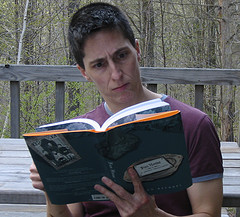Serendip is an independent site partnering with faculty at multiple colleges and universities around the world. Happy exploring!
Notes Towards Day 8 (Sept. 27) : Growing Up Graphic


I. coursekeeping
* naming: how far can we get?
* it's wet; Hannah says meet inside! (we'll aim for the Moon Bench on Tuesday....)
* from Sarah's report on Tuesday's class: "in my role as environmental watchperson, I tried picturing, or sensing, nature as a circle around our circle, that might be sensing us and maybe even supporting us....Every now and then when I thought of it I tried to check back in with this outer circle, and to sense it as holding us. I think this actually helped me to concentrate and to feel like part of our circle...To me today was the first day we started to feel more like a group. Getting to know each other." ;)
* Bechdel @ 7:30 today, plus dessert!
are you ready to talk w/ her?
what do you want to tell her?
what questions do you want to ask?
* writing assignments are 3-pp. reading Bechdel "ecologically" (due tomorrow @ 5 to me and your new writing partner*); and a posting about your experiences @ your "sit site" (due Sunday @ 5)--you might think/write
about how what you are doing is like-and-different from what Bechdel highlights --> could you make your description more "graphic" (draw, photograph, map, video....?)
come to class w/ a copy of your partner's paper, and be ready to talk to her about its STYLE, in the terms we have been using here (rheomode? green grammar? unnatural writing? unified field perception?)
* re-scheduling Monday afternoon conferences for next week (sorry...)
do these @ the same time next Wednesday? (Sara L, Wanhong, Claire, Susan)
* note re: my re-scheduling policy--
if you need to re-schedule and make arrangements ahead of time, fine;
but if you miss a conference w/out letting me know ahead of time, you are out of luck
* new writing partners...
just moving everyone "forward" one on the list:
Barbara<-->Cahier
CMJ <--> Hannah
mbackus <--> mtran
Rochelle <--> Sarah C
Zoe <--> Shengjia
Susan <--> Wanhong
Sarah L <--> alexb2016
* reading assignments for Tuesday are a couple of essays filled w/ writing-and-reading advice:
two essays Gary Snyder published in 1995, "Unnatural Writing" and "Language Goes Two Ways";
and then a 1986 piece by Paula Gunn Allen that describes "Three Approaches to Interpreting a Keres Indian Tale"--you can skim a lot of this: focus on the tale and the third, "tribal-feminist" reading; as always, I'll ask you to apply their advice to your own writing/that of your writing partner (is your writing "natural" or "unnatural"? can it go "two ways"? what would happen, if you approached it in with "open/unified field" perception)?
II. Turning back to Bechdel, helping one another into close readings...
I had asked you to come to class ready to take us to a single page/frame,
not one you'd figured out, but one you can't...one that puzzles you...
pair up and share these...
and then come back to the large group: what haven't you figured out yet?
III. Theorizing the graphic narrative
Scott McCloud describes the difference between easily PERCEIVED images and words,
which need more work to be RECEIVED (=decoded).
Is this an accurate description of your own experience?
Other theorists have described visual language as having
more immediate processing time and a
more "efficient exchange between author(s) and audience;
in part because it's a heavily coded medium, rely on stereotyping:
the broader and more abstract a figure, the closer we come to identifying with it.
Time is spacialized in graphic narratives.
Comics' spatio-topical system foregrounds a relational perspective, by using
word balloons, framing individual panels, gutters (the "blank" space between panels),
strips (the horizontal ban of panel arrangement), various other page layouts.
Graphic narratives give equal weight to text and images,
providing both immediate effect and intellectual engagement;
this leads to persistent metatextuality, as characters regularly cross over into other universes...
IV. the history of graphic narratives
...a new form of sequential art...that recaptures comics' pre-print ancestor..."
think about graphic narratives as contemporary forms of medieval illuminated manuscripts...
* illustrated Bibles (this is from The Holkham Bible, a “celebrated picture-book”/
collection of illustrated Bible stories modernised to appeal to 14th-century Londoners)
* Hieronymus Bosch (15th c. Netherlandish painter)
* Pieter Brueghel the elder (16th c. Netherlandish painter).
Consider also Aya's discussion of William Morris's work on the 1896 Kelmscott Chaucer,
cartoons that incorporated verbal content, such as Hogath's 18th c. sequence,
The Harlot's Progress (punctual, framed moments in an ongoing narrative)...
and movies!
"Before it's projected ... film is just a very very very very slow comic" (McCloud).
Which of these generic forms (note: none are autobiographic) seems to you to operate
most interestingly as an ancestor to Bechdel? What do these comparisons highlight
about what Bechdel is doing? How has she intervened in and altered the various traditions?
direct influences: Charles Addams and Wind in the Willows
V. Let's look more closely @ the use of words, particularly @ the
representation of multiple voices/thoughts/"mind-sets."
Is/how is Bechdel "doubled" in this form?
Does she often think one thing and say another?
How is her "doubleness" represented?



